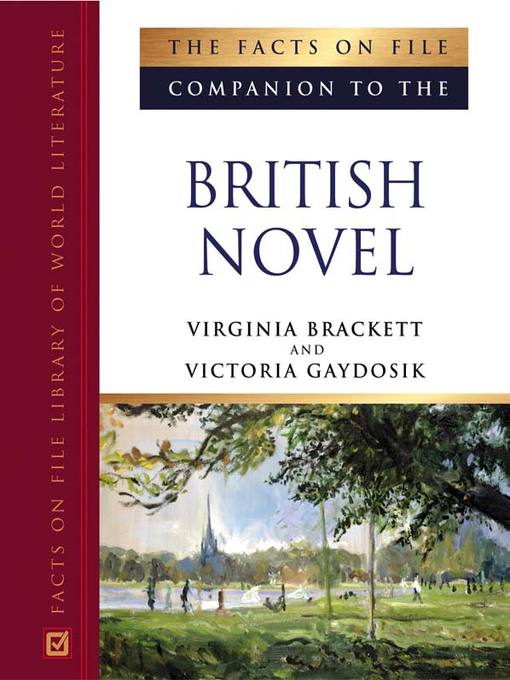
The Facts on File Companion to the British Novel
Companion to Literature
- اطلاعات
- نقد و بررسی
- دیدگاه کاربران
نقد و بررسی

April 1, 2006
Gr 9 Up -Volume one opens with a discussion of the emergence of the novel in Britain and its importance as a representation of British society. Alphabetical entries discuss types, specific titles, literary terms, themes, societies, regions, historical events, people, and places. Works by English, Scottish, Welsh, and Irish writers are included. In her preface, Brackett notes that she attempts -to link each entry to at least one other in the collection -&to demonstrate their unquestionable dependence upon one another -&. - Many lesser-known works and authors not found in other volumes are included, as are quotes. Volume two includes 20th-century authors from the same countries, as well as some from British Commonwealth territories. Articles on Ruth Rendell, Zadie Smith, J. K. Rowling, and Philip Pullman attest to the variety and currency of this guide. Each volume also contains a glossary (with lengthy entries in volume two), a selected bibliography, and a comprehensive index. Volume two has a list of recipients of the Booker Prize, the Whitbread Award, the "Guardian" Fiction Prize, and other awards through 2003 or 2004." -Pat Bender, The Shipley School, Bryn Mawr, PA"
Copyright 2006 School Library Journal, LLC Used with permission.

March 1, 2006
This two-volume companion to the British novel contains more than 1000 A-to-Z entries (each averaging several pages in length) on English-writing authors hailing from either the British Isles or the Commonwealth as well as on novels, pertinent literary terms, themes, concepts, influential periodicals, and subgenres. Authors Brackett (English, Triton Coll.;Restless Genius: The Story of Virginia Woolf ), who has published several reference books and biographies for young adults, and Gaydosik (English, Southwestern Oklahoma State Univ.) divide the work into two parts: Volume 1 covers the British novel from the early 17th up to the 19th century, and Volume 2 begins with the year 1900 and spans to the present. Indexes, appendixes, short bibliographies at the end of many of the entries, a glossary, and cross references are also included.Bottom Line Among the many resources published on this topic, this set's very straightforward style and analytic method reflect a concern that too scholarly an approach might pose a reading comprehension challenge for some readers. This makes it more suitable for high school and public libraries than for college-level collections. As with any such set, libraries that can afford duplication will find some entries here for works and authors not easily found elsewhere.Peter Dollard, Mt. Pleasant, MI
Copyright 2006 Library Journal, LLC Used with permission.

March 15, 2006
Intended for high-school and college students, this resource covers the British novel from its earliest predecessors in the 1600s to the present day, encompassing writers from England, Ireland, Scotland, and Wales as well as Commonwealth countries. Although marketed as a set, these are actually two distinct, independent volumes containing approximately 500 entries apiece. Each volume has its own author, title, introduction, " A-Z "contents, and index. Volume 1, authored by Brackett, covers the British novel from its beginnings through the nineteenth century, while volume 2, by Gaydosik, focuses on the twentieth century. The authors, both English professors at U.S. universities, wrote most of the material in their respective volumes. Substantive and well written, the articles treat a wide range of literary and popular authors and representative novels by them as well as literary themes and movements, fictional genres, significant historical events, social issues, major literary periodicals, and other relevant topics. Most entries are followed by brief secondary bibliographies. Although author entries make no attempt to mention all of a writer's novels, no primary bibliographies are provided. Each volume features extensive cross-references but only to related entries within that particular volume, never to entries in the companion volume. Both volumes include glossaries and exceptionally detailed indexes, which provide a means of identifying novels by genre and theme and locating authors by nationality. Volume 2 also includes a section listing recipients of major British literary prizes.
If the contents of these two volumes had been consolidated into one seamless, integrated set with a single alphabetical sequence and a comprehensive index, this would be an outstanding reference source. Combining these two complementary volumes into one work would have made the set easier to use and also avoided unnecessary duplication (for example, both volumes include entries for Joseph Conrad, Rudyard Kipling, H. G. Wells, and other authors who spanned the nineteenth and twentieth centuries, and both define many of the same literary terms, such as " irony" and " point of view"). Eliminating this duplication would have freed space to cover additional novelists, for example, JohnBanville, David Malouf, and Edith Somerville. In addition, a single alphabetical sequence would have avoided some of the inconsistencies between the volumes. For instance, volume 1 provides a lengthy article on " Children's literature," but volume 2 does not.
As a set, this work has serious shortcomings, but when considered as individual entities, both volumes merit high praise. Because these volumes provide valuable coverage of British novelists and novels to an extent that no other reference source currently does, they will make a useful addition to high-school, public, and academic libraries.(Reprinted with permission of Booklist, copyright 2006, American Library Association.)




دیدگاه کاربران